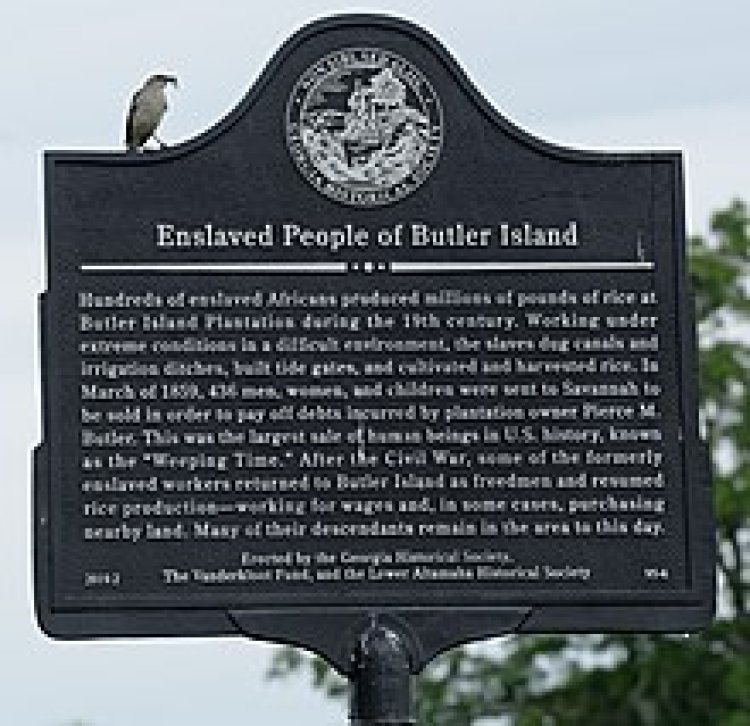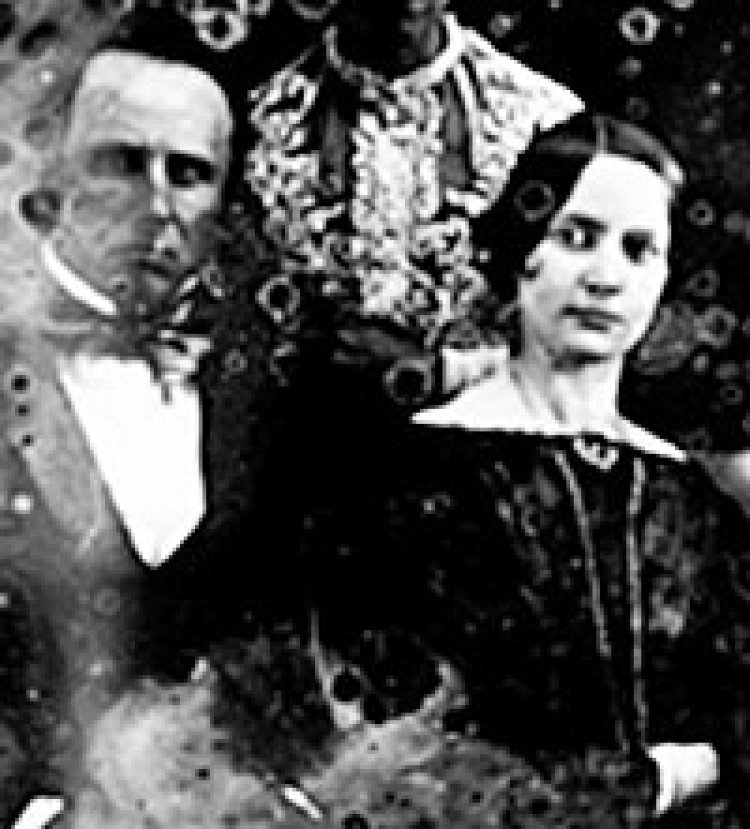यह नीलामी अमेरिकी इतिहास में दासों की सबसे बड़ी बिक्री थी : एक सच
पियर्स बटलर की दास बिक्री का विज्ञापन द सवाना रिपब्लिकन और द सवाना डेली मॉर्निंग न्यूज में सवाना में एक गुलाम डीलर जोसेफ ब्रायन द्वारा किया गया.रविवार को छोड़कर, बिक्री के अंतिम दिन तक विज्ञापन प्रतिदिन चलते थे। कुछ विज्ञापनों का स्लोगन , "बिक्री के लिए, लंबे नीग्रो कपास और चावल में काम करने का अनुभव 2 तारीख को बेचा जाएगा।

द ग्रेट स्लेव ऑक्शन (जिसे वेपिंग टाइम भी कहा जाता है) 2 और 3 मार्च, 1859 को सवाना, जॉर्जिया, संयुक्त राज्य अमेरिका के पास टेन ब्रोएक रेस कोर्स में आयोजित ग़ुलाम अफ्रीकियों की नीलामी थी। गुलाम और बागान मालिक पियर्स मीज़ बटलर ने दो दिनों के दौरान लगभग 436 पुरुषों, महिलाओं, बच्चों और शिशुओं की बिक्री को अधिकृत किया। बिक्री की आय बटलर के कर्ज को पूरा करने के लिए चली गई, इसका अधिकांश हिस्सा जुए का कर्ज था। यह नीलामी अमेरिकी इतिहास में दासों की सबसे बड़ी बिक्री थी.

पियर्स मीज बटलर
दक्षिण कैरोलिना और फिलाडेल्फिया के बटलर बटलर द्वीप और सेंट सिमंस द्वीप पर स्थित बागानों के मालिक थे. परिवार के मुखिया मेजर पियर्स बटलर के पास सैकड़ों दास थे जो चावल और कपास की फसलों पर काम करते थे, इस प्रकार उनके लिए संपत्ति जमा करने के साधन थे। बटलर संयुक्त राज्य में सबसे धनी और सबसे शक्तिशाली दास मालिकों में से एक था। उमेजर बटलर ने अपनी संपत्ति अपने दो पोते, पियर्स मीज़ बटलर और जॉन ए मीज़ बटलर के लिए छोड़ दी।
पियर्स मीज़ बटलर व्यवसायिक थे। वह अक्सर जोखिम भरे व्यवसाय में अपना धन लगाया करते थे , जिसके परिणामस्वरूप 1857 में भारी वित्तीय नुकसान हुआ और जुआ की लत लग गयी बटलर ने पिछले कुछ वर्षों में काफी मात्रा में जुआ के लिए कर्ज लिया। अपने वित्तीय दायित्वों को पूरा करने के लिए, बटलर की संपत्ति का प्रबंधन ट्रस्टियों को स्थानांतरित कर दिया गया था। सबसे पहले, ट्रस्टियों ने बटलर की फिलाडेल्फिया हवेली को $30,000 में बेचा,उन्होंने अन्य संपत्ति भी बेच दी, लेकिन बटलर के लेनदारों को को कर्ज पूरा नही कर पाए। उसके पास बस जॉर्जिया के बागानों काम करने वाले दास ही बचे .
2019 में जॉर्जिया हिस्टोरिकल सोसाइटी द्वारा निर्मित बटलर आइलैंड प्लांटेशन में ऐतिहासिक मार्कर बटलर एस्टेट दास व्यापार का एक बड़ा केंद्र होने के कारण सवाना नीलामी के लिए चुना गया
पियर्स बटलर की दास बिक्री का विज्ञापन द सवाना रिपब्लिकन और द सवाना डेली मॉर्निंग न्यूज में सवाना में एक गुलाम डीलर जोसेफ ब्रायन द्वारा किया गया.रविवार को छोड़कर, बिक्री के अंतिम दिन तक विज्ञापन प्रतिदिन चलते थे। कुछ विज्ञापनों का स्लोगन , "बिक्री के लिए, लंबे नीग्रो कपास और चावल में काम करने का अनुभव 2 तारीख को बेचा जाएगा।
नीलामी शुरू होने से चार दिन पहले दासों को रेस ट्रैक पर लाया गया था, जिससे खरीदार और निरीक्षक उन पर एक नज़र डाल सकें।
बिक्री के पहले दिन करीब 200 खरीदार मौजूद रहे। भीषण बारिश ने कई संभावित खरीदारों को दूर रखा और नीलामी दो घंटे देरी से शुरू हुई।
दासों को घोड़े के खलिहान के स्टालों में रखा गया था। परिवार के सभी सदस्यों को एक ही स्टाल में रखा गया था। स्टालों में उनके पास बैठने और खाने के लिए लकड़ी के फर्श के अलावा कुछ नहीं था। दासों को दो दिनों में खाने के लिए चावल और बीन्स के छोटे हिस्से, और कभी-कभी मकई की रोटी दी जाती थी।
बिक्री सूची में चार सौ छत्तीस व्यक्तियों का विज्ञापन किया गया था, लेकिन 429 बिक गए। जो नहीं बिके वे या तो बीमार थे या विकलांग थे। बेचे जाने वालों में अधिकांश चावल और कपास के खेत के श्रमिक थे; अन्य कुशल कूपर, बढ़ई, मोची, लोहार और रसोइया थे। दो दिन की बिक्री ने $303,850 की शुद्ध कमाई की। एक परिवार, एक माँ और उसके पाँच बड़े हो चुके बच्चों के लिए उच्चतम बोली $6,180 के लिए थी। एक व्यक्ति के लिए कीमतें $250 से $1,750 के बीच थीं।
उस समय के एक लोकप्रिय पत्रकार मोर्टिमर थॉमसन (जिन्होंने छद्म नाम "क्यू. के. फिलेंडर डोस्टिक्स" के तहत लिखा था) ने इस आयोजन को यादगार बना दिया। प्रारंभ में, थॉमसन ने सवाना की यात्रा की और दासों को खरीदने में दिलचस्पी दिखाने का नाटक करके खरीदारों में घुसपैठ की। बिक्री के बाद, उन्होंने न्यूयॉर्क ट्रिब्यून में नीलामी का वर्णन करते हुए एक लंबा और तीखा लेख लिखा, जिसका शीर्षक था, "जॉर्जिया प्लांटेशन पर गुलामों का क्या हुआ।"
एक विक्सबर्ग व्यापारी टॉम पाटे ने इस गारंटी के साथ एक आदमी, उसकी पत्नी और उसकी दो बहनों को बिक्री पर खरीदा था कि उन्हें नीलामी की शर्तों के अनुसार अलग नहीं किया जाएगा। समझौते की अवहेलना करते हुए, पाट ने एक बहन को पैट सोमर्स, एक साथी व्यापारी, और दूसरी बहन को सेंट लुइस में एक निजी नागरिक को बेच दिया। सोमरस, बाद में सवाना में बिक्री समझौते के बारे में पता चला कि परिवारों को अलग नहीं किया जा रहा है, लड़की को अपने पैसे वापस करने की मांग करते हुए पाटे को वापस कर दिया। सोमरस की गोली मारकर हत्या करने के परिणामस्वरूप एक तर्क छिड़ गया। सोमरस की मृत्यु के दस दिन बाद, उसके भतीजे ने पाटे को मार डाला, और वह स्वयं टकराव के दौरान मारा गया। यह झगड़ा तब तक जारी रहा जब तक कि पाटे नाम के प्रत्येक व्यक्ति को मार नहीं दिया गया।
मुक्ति उद्घोषणा और संघीय राज्यों की हार से दासों को मुक्त करने के बाद, उनमें से कुछ मजदूरी के लिए काम करने के लिए बटलर द्वीप लौट आए और कुछ ने क्षेत्र में जमीन खरीदी।
ऐतिहासिक मार्कर
इस घटना को उजागर करने के लिए जॉर्जिया के दो ऐतिहासिक चिह्नक मौजूद हैं। एक सवाना, जॉर्जिया में 2053 ऑगस्टा एवेन्यू में है, जिसे 2008 में शहर और जॉर्जिया हिस्टोरिकल सोसाइटी द्वारा बनाया गया था।[1] दूसरा बटलर प्लांटेशन में है, जिसे 2019 में जॉर्जिया हिस्टोरिकल सोसाइटी द्वारा बनाया गया था।
This Auction Was the Biggest Sale of Slaves in American History: One Truth
Pierce Mies Butler
Butlers from South Carolina and Philadelphia owned plantations on Butler Island and St. Simons Island. The head of the family, Major Pierce Butler, had hundreds of slaves who worked on the rice and cotton crops, thus accumulating wealth for them. Butler was one of the wealthiest and most powerful slave owners in the United States. Umejer Butler left his estate to his two grandchildren, Pierce Meese Butler and John A. Meese Butler.
Pierce Mies Butler was a businessman. He often invested his money in risky business, which resulted in heavy financial losses and gambling addiction in 1857. Butler took a considerable amount of gambling debt over the years. To meet his financial obligations, management of Butler's assets was transferred to trustees. First, the trustees sold Butler's Philadelphia mansion for $30,000, they also sold other assets, but were unable to pay off debts to Butler's creditors. He was left with only slaves working in Georgia's plantations.
auction
The historic marker Butler Estate at Butler Island Plantation, built by the Georgia Historical Society in 2019, was selected for the Savannah Auction for being a hotbed of the slave trade
Pierce Butler's slave sale was advertised in The Savannah Republican and The Savannah Daily Morning News by Joseph Bryan, a slave dealer in Savannah. Ads ran daily until the last day of the sale, except on Sundays. Some advertisements with the slogan, "For sale, experience working in long negro cotton and rice will be sold on the 2nd.
The slaves were brought to the race track four days before the auction began, allowing buyers and inspectors to take a look at them.
About 200 buyers were present on the first day of the sale. Heavy rains kept many potential buyers away and the auction started two hours late.
Slaves were kept in horse barn stalls. All the family members were kept in the same stall. In the stalls they had nothing but wooden floors to sit and eat. Slaves were given small portions of rice and beans, and sometimes corn bread, to eat over two days.
Four hundred and thirty-six persons were advertised in the sales list, but 429 were sold. Those who did not sell were either sick or disabled. Most of those sold were rice and cotton farm workers; Others were skilled coopers, carpenters, cobblers, blacksmiths and cooks. Two days of sales netted $303,850. The highest bid was for $6,180 for a family, a mother and her five grown children. Prices ranged from $250 to $1,750 for one person.
Mortimer Thomson (who wrote under the pseudonym "Q.K. Philander Dostics"), a popular journalist of the time, made the event memorable. Initially, Thomson traveled to Savannah and infiltrated buyers by pretending to be interested in buying slaves. After the sale, he wrote a long and scathing article in the New York Tribune describing the auction, titled "What Happened to the Slaves on the Georgia Plantation."
Tom Pate, a Vicksburg merchant, bought a man, his wife and his two sisters on sale with the guarantee that they would not be separated according to the terms of the auction. Defying the agreement, Pat sold one sister to Pat Somers, a fellow businessman, and the other sister to a private citizen in St. Somers, after learning of the sale agreement in Savannah that the families were not being separated, returned the girl to Pate, demanding her money be returned. An argument broke out as a result of Someras being shot dead. Ten days after Somers died, Pate was killed by his nephew, and he himself was killed during the confrontation. The fight continued until everyone named Pate was killed.
After the Emancipation Proclamation and the defeat of the Confederate States freed slaves, some of them returned to Butler Island to work for wages and some bought land in the area.
historical marker
There are two Georgian historical markers to highlight this event. One is at 2053 Augusta Avenue in Savannah, Georgia, which was built in 2008 by the city and the Georgia Historical Society.[1] The other is at Butler Plantation, which was created by the Georgia Historical Society in 2019.

































